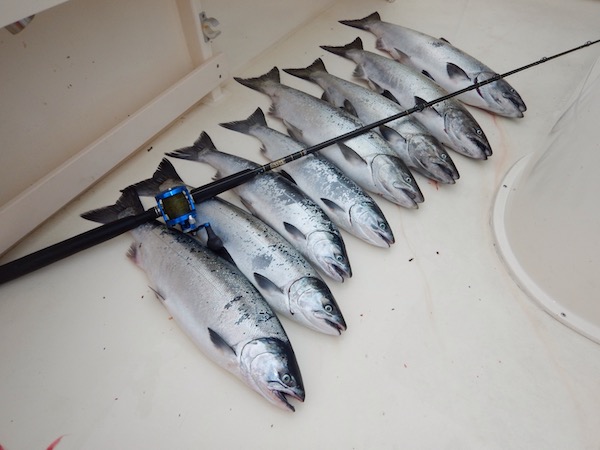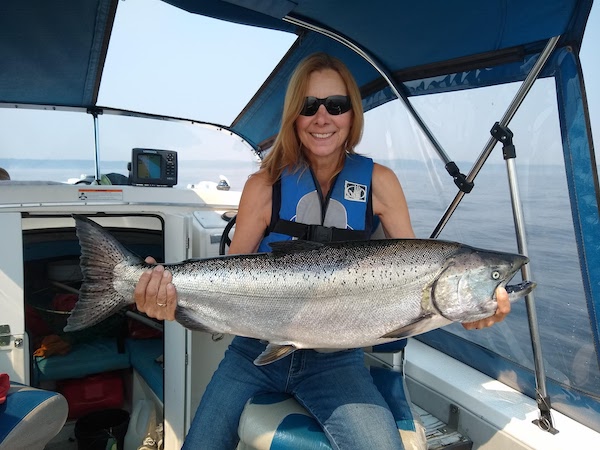
WA, OR Ocean Salmon Options Out; Big Coho Quota Jump Possible
THE FOLLOWING IS A PRESS RELEASE FROM THE PACIFIC FISHERY MANAGEMENT COUNCIL
The Pacific Fishery Management Council has adopted three alternatives for 2022 ocean salmon fisheries off Washington, Oregon, and California for public review. The Council will make a final decision on salmon seasons at its meeting on April 6-14. Detailed information about season starting dates, areas open, and catch limits for the three alternatives are available on the Council’s website at www.pcouncil.org.
Forecasts for many Chinook and coho stocks have improved over last year; however, the Council is constrained by requirements to conserve Fraser River (Canada) coho, lower Columbia River natural tule1 fall Chinook, and Klamath River fall Chinook.

“Meeting our conservation and management objectives continues to be the highest priority for the Council,” said Council Chair Marc Gorelnik. “Balancing those objectives while providing meaningful commercial and recreational seasons remains a challenge in 2022.”
“The prey needs of Southern Resident killer whales is an important piece of the Council’s salmon fishery deliberations”, said Executive Director Merrick Burden, “as is the need to rebuild salmon stocks that have become overfished.”
Washington and Northern Oregon (north of Cape Falcon)
Fisheries north of Cape Falcon (in northern Oregon) are limited mainly by the need to constrain catch of lower Columbia River natural tule Chinook. Additionally, three coho salmon stocks are categorized as overfished (Queets River, Strait of Juan de Fuca) or not overfished/ rebuilding (Snohomish), which is also a concern when structuring 2022 fisheries.
Tribal ocean fisheries north of Cape Falcon
Tribal negotiations are underway, but at this time the Chinook and coho quotas for tribal ocean fishery alternatives range from 30,000 to 50,000 for Chinook salmon (compared to 40,000 in 2021), and from 42,000 to 62,000 coho (compared to 26,500 coho in 2021). Under the range of alternatives, seasons open May 1 and continue through September 15.
Commercial season alternatives
For the non-Indian ocean commercial fishery North of Cape Falcon, the alternatives reflect traditional seasons between May and September. Chinook quotas for all areas and times range from 26,500 to 32,500, compared to 30,750 in 2021. Coho quotas range from 25,600 to 33,600 marked coho, compared to 5,000 in 2021.
Sport season alternatives
For the ocean sport fishery north of Cape Falcon the alternatives with Chinook recreational quotas range from 26,500 to 32,500, compared to 27,250 in 2021. For coho, recreational quotas range from 134,400 to 176,400 marked coho, compared to 70,000 in 2021. Starting dates range from mid- to late-June and ending dates range from mid-to late-September. Chinook and coho retention is allowed generally throughout the proposed seasons.

Oregon (south of Cape Falcon) and California
Fisheries south of Cape Falcon are limited mainly by the low abundance forecast for Klamath River fall Chinook, and the need to protect ESA-list California Coastal Chinook. Klamath River and Sacramento River fall Chinook contribute significantly to ocean harvest. This year’s management alternatives are designed to provide fishing opportunity for the more abundant Sacramento River fall Chinook while reducing fishing impacts on Klamath River fall Chinook and California Coastal Chinook.
Commercial season alternatives
Commercial season alternatives south of Cape Falcon to Humbug Mountain are open either beginning in late March or May through October, with closed periods in most months. A limited incidental hatchery coho season is also being considered.
The commercial alternatives in the Oregon Klamath Management Zone provide a range of Chinook only season alternatives opening from late March through May, and include quotas in June , July, and August. All alternatives have the California Klamath Management Zone closed for the season.
Commercial seasons south of the California Klamath Management Zone vary considerably between the alternatives and management areas (Fort Bragg, San Francisco, and Monterey), but in general provide significantly reduced levels of opportunity compared to last year.
Sport season alternatives
Chinook fishing in the Tillamook, Newport, and Coos Bay areas all open March 15 with Alternative 1 running continuously through October 31, similar to the 2021 season. Alternative 3 has August closed to Chinook retention.
Oregon ocean recreational alternatives include mark-selective coho fishing seasons starting in mid- to late-June and running through most or all of August south of Cape Falcon, with intermittent non-Chinook retention periods in specific areas. Quotas range from 95,000 to 110,000 marked coho (compared to 120,000 in 2021). In addition, nonmark-selective fisheries are proposed in all alternatives for the area between Cape Falcon and Humbug Mountain starting in September, with quotas ranging from 17,000 to 20,000 coho (compared to 14,000 in 2021).
The range of alternatives include proposed fisheries for the Klamath Management Zone in both California and Oregon with the majority of the fishing opportunity occurring June through August in Oregon and occurring over varying dates between May and September in California.
California ocean recreational alternatives for the Fort Bragg and San Francisco areas have reduced opportunity compared to 2021, whereas alternatives for the Monterey area have similar or increased opportunity. Seasons vary between management areas.
Management Objectives for Southern Resident Killer Whales
The Council worked collaboratively with National Marine Fisheries Service (NMFS) to understand the effects of Council-area fisheries on Southern Resident killer whales, which are listed as endangered. Based in part on information provided by the Council’s ad-hoc Southern Resident Killer Whale Workgroup, the Council amended the Pacific Salmon Fishery Management Plan to address the needs of the whales while providing salmon harvest opportunities. Salmon abundance is well above the threshold of 966,000 Chinook that would require additional fishery restrictions.
Management Process
The Council has scheduled one public hearing for each coastal state to hear comments on the alternatives. The hearings will occur online and are scheduled for Tuesday, March 22 (Washington and California) and Wednesday March 23 (Oregon). The public will also be able to comment on the alternatives during the April Council meeting.
Materials and instructions for joining online Council meetings and hearings will be posted to the Council website.
The Council will consult with scientists, hear public comment, revise preliminary decisions, and choose a final alternative at its meeting April 6-13.
The Council will forward its final season recommendations to NMFS for its approval and implementation no later than May 16.
All Council meetings are open to the public.

